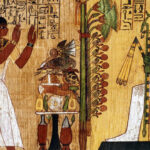The role of women in Ancient Egyptian society was complex and multifaceted, as women held a variety of important roles in both the private and public spheres. Although Ancient Egypt was a patriarchal society, women enjoyed more rights and freedoms than their counterparts in many other ancient civilizations.
In Ancient Egypt, women had the right to own and inherit property, conduct business, and serve as priestesses in the temple. Women could also serve as midwives, doctors, and scribes, and were often responsible for overseeing the education of their children. They were highly valued for their ability to bear children, which was considered essential to the survival and prosperity of the family and the community.
One of the most prominent roles for women in Ancient Egypt was that of the queen, who was not only the wife of the Pharaoh but also held significant power and influence in her own right. The queen was often involved in the administration of the kingdom, including overseeing the construction of public works and serving as a mediator between the Pharaoh and his subjects. Queens such as Hatshepsut and Nefertiti are remembered for their significant contributions to Ancient Egyptian society and culture.
Hatshepsut, who ruled as Pharaoh from 1478 to 1458 BCE, is remembered as one of the most successful Pharaohs in Ancient Egyptian history. She oversaw the construction of many monumental buildings, including her own mortuary temple at Deir el-Bahri, which is considered one of the greatest architectural achievements of the Ancient world. Hatshepsut is also remembered for her diplomatic efforts, as she sent expeditions to trade with the kingdom of Punt, a region on the east coast of Africa, and established peaceful relations with neighboring kingdoms.
Nefertiti, the wife of Pharaoh Akhenaten, is remembered for her beauty and her role as a patron of the arts. She was a skilled artist in her own right, and many works of art from the Amarna period depict her with her husband and their children. Nefertiti was also a devout follower of the Aten, the sun god, and played an important role in the religious reforms of her husband’s reign.
Women in Ancient Egypt also made significant contributions to the fields of science and medicine. Many women served as midwives and healers, and some women, such as Merit-Ptah, are believed to have been among the first female physicians in history. Merit-Ptah was the chief physician to the Pharaoh during the 3rd Dynasty, and she is remembered today as a pioneer in the field of medicine.
In addition to their contributions in the fields of art, architecture, and medicine, women in Ancient Egypt also played an important role in the development of the Egyptian language and writing system. Women were often responsible for overseeing the education of their children, and many girls were taught to read and write alongside their brothers. Some women, such as the scribe Ahmose-Nefertari, held high-ranking positions in the royal court and were responsible for recording important events and transactions.
Finally, the role of women in Ancient Egyptian society was varied and complex, and women made significant contributions to the culture and legacy of this ancient civilization. From the queen to the midwife, women held important positions in both the private and public spheres, and their contributions in fields such as art, architecture, medicine, and education continue to influence and inspire people around the world today.

![]()








GIPHY App Key not set. Please check settings